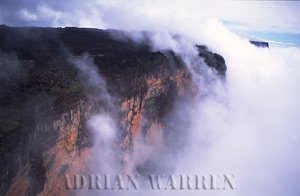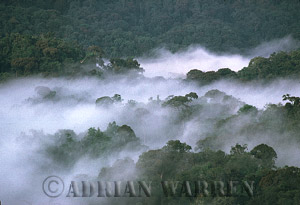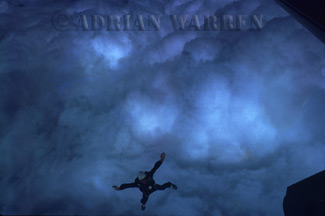By Adrian Warren
INTRODUCTION
I am going to try to give some general views on aerial filming techniques, focusing on some of my own preferred methods, recognising that these are by no means necessarily the best.
As well as the use of aircraft as camera platforms, I am going to include in this discussion techniques we have employed for moving the camera horizontally through the canopy of the rain forest since I feel that this also constitutes a kind of aerial filming.
Most experienced film camera operators have their own preferred methods in aerial filming techniques, finely tuned over the years; for each person, it has probably been a slow process of evolution to find the best method to overcome the principal problems in aerial cinematography: vibration, bumpy air and how to mount the camera. In the end, however it is achieved, there is nothing more pleasing than a well-executed, smooth and steady aerial shot.
My own preference for camera angle is a forward facing one - I feel it is dynamic and more interesting than the conventional sideways tracking shot, although sometimes it can be useful to have a combination of both for editing purposes.
The major factors affecting aerial filming fall into two categories: those which are under control and those which are definitely beyond anyone's control. Controllable factors include a good camera mount (which may just mean the person who is holding the camera); a reliable camera; good choreography; and safety conscious working rules. Uncontrollable factors include the weather; turbulent or bumpy air; vibration; and squashed insects or dirt on the lens.
I cannot stress enough the importance for safety - many people, even the most experienced camera operators and pilots have lost their lives through trying to push the limits just a bit too far to get that difficult shot, or simply by letting their concentration slip for a vital moment. Inevitably, aerial filming can lead us into flying low level, or close to cliffs, trees or other obstacles, where it only takes a bird to take off, wind shear, or an aircraft problem to put us into a potentially fatal situation. It can all be over in seconds.
So why do we want aerials in our films?
For me, aerial shots put sequences filmed on the ground into perspective by making sense of the place geographically, and add a new dimension from which to visually appreciate the beautiful and remote places in which we work. They can also be a useful tool to transport the audience from one place to another; or develop a certain mood, or a change of pace in the story.
What style of aerial fits the mood of the film?
Whether you want to float gently over landscapes; film a fast moving aerial action sequence; follow herds of animals, migrating birds, cars, boats or aeroplanes; it is important to work out early on what style of aerial will fit your film. Once that decision is made you can then think about how you are going to film it - what kind of aircraft you are going to use, and how you want to place the camera on the aircraft, for a sideways view with the camera in the hands of the camera operator; or a remote, forward or backward facing, one. Most probably there will be budgetary restrictions that come into play here to affect your choice too.
The Importance of Choreography
It is most important to plan in great detail, and discussions of shots in detail between Director, Camera operator, and Pilot before leaving the ground are essential. Once in the air it is noisy and windy, especially with the door of an aircraft removed; and time spent in the air in discussion, or indecision, is an expensive waste of time. If everyone knows what is expected before take off, then there might even be time for a rehearsal run before running the camera, to ensure the shot will work as planned and to take stock of local wind conditions. A rehearsal can be especially important if the pilot and camera operator have not worked together before, so any unexpected surprises can be compensated for on the "Take Run".
The Weather
Changing weather can be a dramatic backdrop to any scene, but unstable air causes problems for both pilot and camera operator. Turbulence will be found under even the most harmless looking fluffy white cumulus cloud. In turbulent air, smooth flight is impossible. Conditions may look good but bumpy air can be encountered over trees, buildings, and even roads where ground heating, due to reflective surfaces, is variable. In mountainous or hilly areas one has to be especially careful of windshear and downdraughts which can seriously wreck your day. The results of these are shots that pitch and bounce on the screen. Better to choose stable weather periods, such as early morning or the short period just before sunset; when the light tends to be more dramatic anyway.
If the air is bumpy, and you have to fly, you can always smooth things out a bit by over cranking the camera. The resulting slow motion gives the impression of floating gently over the ground subject matter, as if one was filming from a balloon. But beware, shooting ratios increase radically when over cranking, and if you slow the shots down too much they become boring to watch, however exciting the landscape.
What film format?.....or video?
This is a question that is probably predetermined by the budget, but the format that you find yourself working with will have a bearing on your choice of aircraft type and the camera mount that you are going to use (if any). If you are working with video, or 16mm, you may choose to approach the whole thing very simply, but as soon as you move up to 35mm or larger, for example IMAX, camera control and therefore image stability become essential prerequisites for acceptable aerial photography. It becomes necessary to use complex camera mounts, and may demand special adjustments to the aircraft such as helicopter rotor balancing, to reduce vibration to a minimum.



